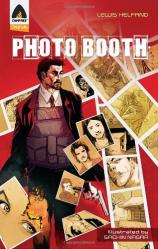Photo Booth
Review
Photo Booth
Over the last year or two, the Indian publisher Campfire has put out several dozen graphic novels adapting public domain stories (20,000 Leagues Under the Sea, Gulliver's Travels), along with a few biographies of well-known figures. Photo Booth is different. It's an original story—apparently the only completely original work that Campfire has published to date—and it's an ambitious attempt that deserves notice.
Campfire bills this book as a romantic thriller, and it's that and a bit more. It's about a reckless Interpol agent, Praveer Rajani, who is on the trail of a criminal gang flooding the streets with a new and dangerous drug. But the drug also has mysterious ties to the automobile accident that killed Rajani's parents 20 years ago. And tied to the drug and the mystery of his parents' death are sheets of photographs, taken at a carnival photo booth, that magically changes to show different people, different situations, and different locations, some of which might be clues to the drug case Rajani is working. And on top of that is a tale of love, featuring Rajani's brother Jayendra and the woman he almost lost.
It's all a bit too much for one story, and the whole coincidence of the parents' death being tied to the drug that's just hitting the streets 20 years after the car accident that orphaned their children is hard to accept. But writer Lewis Helfand uses the whole laundry list of interconnected plot elements to tell a story of a family torn apart and the fragility of love, and that gives the graphic novel its very real emotional core.
Helfand tells a good story, although much of the police work he depicts does not ring true. His cops are tough-guy analogs, not real characters, and nothing about their case moves like a real investigation. It's a shame; this could have been a much more powerful story if the emotional core were attached to a more believable plot.
Artist Sachin Nagar uses two styles in this book: a stark, sketchy, ink-strewn black-and-white style for the modern sequences that start and end the tale, and a more colorful approach (with Photoshop-heavy hues by Prince Varghese) for the flashback to the past, which takes up more than half of the novel. He packs a lot of detail onto the page, and his characters have excellent body language, especially in relation to each other. Nagar isn't as good depicting action, and he tends to stick to rather bland, emotionless character expressions, but his layouts are solid and move the story along ably.
Like all of Campfire's books, Photo Booth ends with a couple of pages of kid-friendly back-matter, offering a few lessons from the preceding story (in this case, it's photography tips and some trivia about Interpol). It seems like an odd inclusion, since this is a decidedly older story, for teens and above, while the back pages are designed for children.
All in all, Photo Booth is a graphic novel that tries and sometimes succeeds. I am eager to see what Helfand and Nagar produce in the future.
Reviewed by John R. Platt on July 12, 2012
Photo Booth
- Publication Date: June 21, 2011
- Genres: Graphic Novel
- Paperback: 80 pages
- Publisher: Campfire
- ISBN-10: 9380028652
- ISBN-13: 9789380028651



